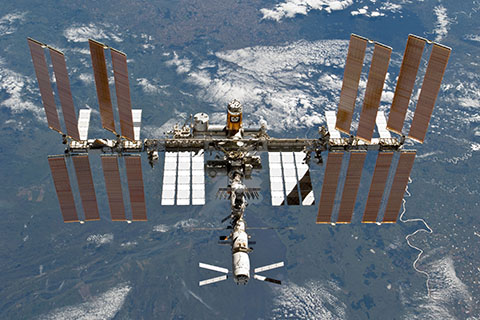About International Space Station (ISS) and Japanese Experiment Module "Kibo"

Photo by NASA |
The ISS project promoted through international cooperationThe International Space Station (ISS) is the largest manned space facility in human history at approximately 400 km above the Earth. It is about 108.5 m x 72.8 m, or about the same size as a football pitch, with a mass of about 420 tons. |
|---|
The major purpose of the ISS is to further improve science and technology to be useful for lives and industries on the ground.
Fifteen countries participate in the ISS project including the United States, Russia, European Countries, Canada, and Japan. Japan contributes to this international project of adopting the latest technology from each participating country through the Japanese Experiment Module "Kibo" and the H-II Transfer Vehicle "KOUNOTORI" (HTV, a cargo transfer vehicle to the ISS.)
Project Topics
indexTowards the Operations and Utilization of the ISS Beyond 2025 - Multilateral Coordination Board (MCB) Meeting Held
|
On August 22, 2023, the International Space Station Multilateral Coordination Board (ISS MCB Meeting) was held at the NASA Kennedy Space Center in United States, and JAXA participated as a member of the ISS Partnership. The ISS MCB Meeting serves as the top-level international coordination meeting for the ISS program, where important matters related to the operations and utilization of the ISS are regularly discussed. This meeting marked the first of its kind after Canada, Europe, R... |
Press Release
indexCharacteristics of International Space Station (ISS) and Japanese Experiment Module "Kibo"
1.Japan's first facility for manned space activities: Japanese Experiment Module "Kibo"
|
The Japanese Experiment Module "Kibo" is Japan's first manned experiment facility, and it is the largest experiment module on the International Space Station (ISS.) The Kibo consists of two experiment facilities, the Pressurized Module (PM) and the Exposed Facility (EF.) The PM is 11.2 meters long and 4.4 meters in diameter, and the inside atmospheric pressure is maintained to 1 atm. Astronauts can move around between the PM and other ISS modules in their plain clothes. Scientific experiments using the microgravity environment and cosmic radiation are being carried out on the experiment racks in the PM. The EF is directly exposed to space, and it is a unique facility among ISS laboratories as it enables long-term experiments in open space as well as Earth and astronomical observations. |
 |
|---|
The PM is equipped with an airlock, thus we can move an experiment device directly from the PM to the EF, and vice-versa, through the airlock by manipulating the Kibo's robotic arm (JEMRMS.)
Kibo's docking and assembly operations have been completed as the Pressurized Module was assembled in June 2008, and the Exposed Facility in July 2009.
2.To acquire manned space technology
|
The ISS, where astronauts stay, requires extremely high-level safety. It is needless to say that each component of the ISS must be safe. Moreover, if an anomaly occurs somewhere on the ISS, that should not immediately harm people's lives; therefore, double or triple safety measures are taken. For Japan, the Kibo is the very first manned space facility, thus its development was full of challenges, and we had to overcome many hurdles. As we have learned a lot from NASA and other foreign space agencies who had already obtained manned space technology, Japan has absorbed this knowledge, sublimated it, and materialized it as the Kibo. Consequently, the Kibo became a very highly accomplished experiment module which is even praised by foreign astronauts. |
 |
|---|
The Kibo is monitored and operated by the JAXA Flight Control Team (JFCT) from the Kibo Mission Control Room at the Tsukuba Space Center. Collaborative operations among ISS member nations are essential to operate the ISS safely. JAXA was able to acquire the knowhow to operate a manned space facility through the Kibo's operations.
Such experience and knowledge are incorporated into the development and operation of the H-II Transfer Vehicle "KOUNOTORI" (HTV, a cargo transfer vehicle to the International Space Station.)
3.Further application of the Kibo
|
Technologies acquired through our aerospace development have been applied to many other fields (spin-offs.) Especially, the manned space technologies that used to be exclusively developed mainly in the U.S. and Russia have now become available and adapted in many areas that are closely related to our daily lives. As the Kibo is now completed, Japan possesses a manned space facility of which Japan has priority of use. Our next challenge is how to utilize the Kibo. JAXA asks universities and other academic institutions to offer experiment themes for utilizing the Kibo, and conducts collaborative research with private companies. We also began a system of Kibo usage through which the private sector can use the Kibo with some fees. We hope that space experiments and application will become more familiar to our lives through the Kibo. |
 |
|---|

